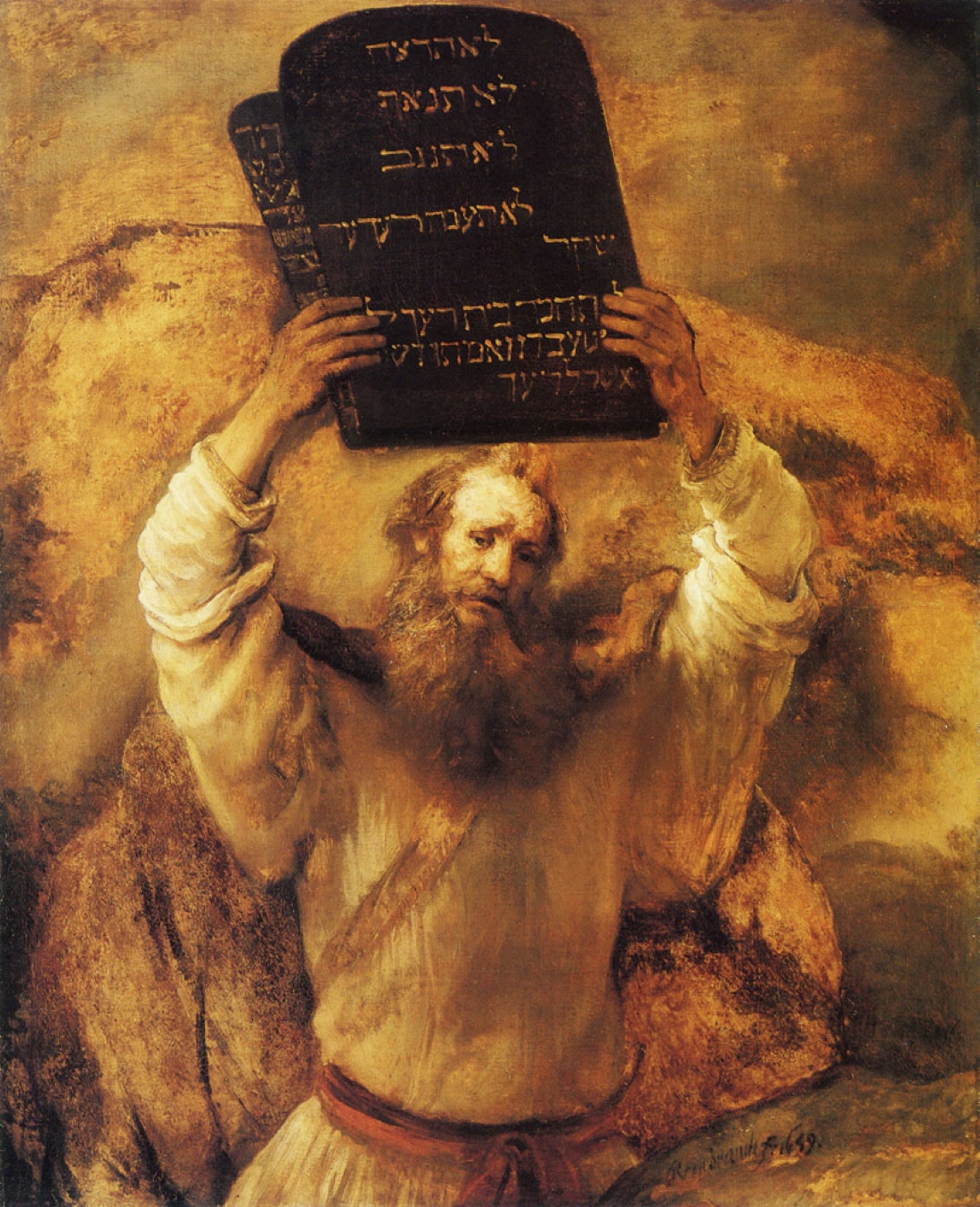This post continues my series on Jesus, divorce, and remarriage, where I’m examining Jesus’ words beginning with this question: Did Jesus believe that marriage is indissoluble? Here are my posts so far:
Jesus on Divorce and Remarriage: Introduction (JDR-1)
Hyper-Literalism, Could vs. Should, and a Guiding Question (JDR-2)
“Cleave” Does Not Imply an Unbreakable Bond (JDR-3)
“One Flesh” Does Not Imply an Unbreakable Bond (JDR-4)
“God Has Joined Together” Does Not Imply an Unbreakable Bond (JDR-5)
Genesis 2:24 as God’s Creation Norm for Marriage (JDR-6)
“Let Not Man Separate” Implies a Breakable Bond (JDR-7)
Summary of this post: I ask whether Jesus’ statement that “Moses allowed” divorce provides any clues about whether marriage is indissoluble. After showing that Jesus was not pitting Moses against God, I survey what God’s law said about divorce. Some laws narrowly commanded divorce; others narrowly forbade it. Multiple laws assumed divorce and that divorce dissolves a marriage. The famous Deuteronomy 24 passage prohibited a man from remarrying his former wife who had meanwhile been married to another. This passage is joined by others that likewise grouped divorce and death as equally and truly ending marriage.
Introduction: Was Marriage Indissoluble Under the Law of Moses?
Jesus wrapped up his summary of God’s creation design for marriage in Matthew 19:3-6 with a strong command: “What therefore God has joined together, let not man separate.”
The Pharisees were not satisfied with this response. They countered with a question, alluding again to Deuteronomy 24:1: “Why then did Moses command one to give a certificate of divorce and to send her away?” (Matt. 19:7). Doesn’t this mention of a “certificate of divorce” imply that it is “lawful” (Matt. 19:3) to divorce a wife?
Jesus’ rebuttal focused again on God’s creation design for marriage: “Because of your hardness of heart Moses allowed you to divorce your wives, but from the beginning it was not so” (Matt. 19:8). In other words, yes, it may have been “lawful” under the law of Moses to divorce, but that same law, in its record of the creation, shows that divorce was not part of God’s original and unchanging design. In short, the should of marriage permanence remains clear, despite the certificates of divorce allowed under Moses.[1]
But does Moses’ allowance of divorce indicate anything about whether a marriage could be dissolved by anything other than death? Do the practices of divorce and remarriage under the law of Moses suggest that divorce was always only a legal fiction? Or do they suggest that marriages really could be dissolved, despite God’s creation intent?
As I address these questions in this post, I will focus on the first main clause in Jesus’ sentence: “Moses allowed you to divorce your wives.” From the perspective of what was uppermost in Jesus’ mind, the other two clauses are even more important (“Because of your hardness of heart… but from the beginning it was not so”). I plan to address those clauses directly in a future post or two. First, however, I want to consider what we can learn from Jesus’ acknowledgement that Moses allowed divorce.
So, what does the law of Moses say about divorce? And do its laws about divorce give any indication as to whether marriage is indissoluble or not? Let’s survey some of the most important evidence for clues.

The Law of Moses: Two Possible Misunderstandings
Two likely misunderstandings must be cleared up right away. First, Jesus is not pitting Moses against God. Jesus is not saying “God forbade divorce but Moses dishonored God by allowing it anyway.” Jesus is never recorded as speaking negatively of Moses.[2] He believed the law of Moses came from God himself; in fact, in this very conversation with the Pharisees Jesus has already attributed an editorial comment from Moses (“Therefore, what God has joined…”) to God (“he who created them”).[3]
The suggestion that Jesus’ words “Moses allowed” are describing “a merely human deviation from the divine purpose” is “a very modern inference,” as commentator R. T. France noted. Rather, “the laws given by Moses were understood to be the laws of God; ‘Moses’ means the Pentateuch, the God-given body of law which is Israel’s highest authority.”[4] Thus, whatever commands we find in Moses’ law must be seen as coming from God himself.
Second, we should note that the law cited by the Pharisees, which is found in Deuteronomy 24:1-4, is really a law about remarriage, not divorce. This law is essentially a long “if” followed by a short “then” command. A summary version could read, “If a man divorces his wife, she remarries, and her second marriage comes to an end, then the man may not take her back as his wife again.”[5] Thus, Dean Taylor rightly wrote of this passage, “Moses did not institute divorce, he merely regulated against a type of remarriage.”[6] That said, it remains true, as Jesus acknowledged, that this law of Moses did “allow” divorce.
Laws Requiring Divorce
What is less well known is that in some cases the law of Moses actually required divorce. For example, in Exodus 21:11 a master-husband was instructed to give his Hebrew slave-wife her food, clothing, and marital rights, without diminishing them if he took another woman. If he withheld these rights, the law commanded that “she shall go out for nothing” (Ex. 21:11; cf. Ex. 21:26). Similarly, Deuteronomy 21:14 commanded that if a man “no longer delight in” his wife whom he had taken as a captive in war, he must “let her go where she wants” without selling her or treating her as a slave.
Both these passages contain linguistic links to the famous divorce and remarriage passage in Deuteronomy 24:1-4, links suggesting that these passages are talking about full divorce, complete with the right to remarry.[7] They also appear to be talking about real marriage, despite the wife being originally secured by either slavery (temporary indentured servitude of a fellow Hebrew) or captivity (of a foreign enemy). If either of these seems least likely to qualify as real marriage, it would be the captive wife. Yet the Deuteronomy passage says explicitly, “you may… be her husband, and she shall be your wife” (Deut. 21:13). Further, that passage occurs right before a paragraph that demands that unloved “wives” be given equal rights as loved ones, a command that parallels the one in Exodus 21:11.
If a wife taken as a slave or captive had a right to secure a divorce if her husband would not provide for or “delight in” her, then surely a wife gained by more normal means had equal rights or better. Thus, Jews in Jesus’ day applied this passage to all marriages. They “recognized that the obligations of Exodus 21:10-11 could form the basis of a claim for divorce,” and “rabbinic literature preserves detailed discussions concerning the exact limits for gaining a divorce on the grounds” in that passage.[8]
It is worth noting that some of the authors who have been influential for conservative Anabaptists on the topic of divorce (Coblentz, Webb, Wenham, etc.) do not even mention Exodus 21:11 or Deuteronomy 21:14.[9] Several make statements that are clearly false in light of these passages. For example, Cornes wrote the following in his summary of the OT law:
Any individual law which specifically legislates about divorce only limits its availability. The law must therefore be seen as restraining divorce rather than enabling it.[10]
Wenham and Heth likewise exclaimed, “There is, in fact, no legislation respecting grounds for divorce in Old Testament law!”[11]
Kuruvilla, drawing on Cornes, made a similar claim, even extending it to include the entire OT:
Throughout the Old Testament, there is no “enabling legislation” for divorce. Instead, Old Testament laws merely restrict a practice that was already ongoing… Nowhere in the Old Testament are any statements given that “enable” divorce or remarriage.[12]
Contrary to these claims, Exodus and Deuteronomy both clearly command that if a husband refused to care for his (slave or captive) wife, he must grant her the freedom of a divorce. Would God, through Moses, have commanded that wives of abusive husbands be freed to remarry if he thought that their first marriages remained undissolved?

Laws Prohibiting Divorce
Other laws provided for women by protecting them from wrongful divorce. For example, what if a husband took a wife, decided he didn’t like her after having sex with her for the first time, and then tried to get rid of her by falsely accussing her of not being a virgin? Such a man was to be whipped and fined, and “he may not divorce her all his days.” He had to provide for her for life, without exception, for he had “brought a bad name upon a virgin of Israel” and put her in danger of wrongful capital punishment (Deut. 22:19). Similarly, the rule for a man who raped an unbetrothed virgin was that he had to marry her and “may not divorce her all his days” (Deut. 22:29).[13]
As far as I can discover, author Rubel Shelly is right in saying that these are “the only two specific situations named in which a man could not divorce his wife” under the law of Moses.[14] And presumably, if a wife in these two situations was later uncared for, she could go to court to sue for either provision or her own right of divorce under the precedent of Exodus 21:11 or Deuteronomy 21:14.
How widely was divorce practiced in OT Israel? Given the pattern of Israel’s other sins, Instone-Brewer is probably right in saying “we must assume that divorce was as prevalent in Israel then as in other ancient Near Eastern societies.”[15] What is clear is that divorce was widely “allowed” under the law of Moses and sometimes even commanded. Was God allowing something that was a legal fiction, or was he allowing (and sometimes commanding) something that was real, even though it fell short of his original design for marriage?
A Law Prohibiting Remarriage
Deuteronomy 24:1-4 supports this picture of easily-available divorce. I’ve already summarized the basic point of the passage, and I’ll reinforce that summary now by emphasizing that the Jews in Jesus’ day entirely missed the point of the passage when they mined it in search of valid grounds for divorce. The passage does not provide grounds for divorce but restrictions against a certain kind of remarriage.
Let me quote the passage in full and then we’ll look for clues about marriage permanence.
When a man takes a wife and marries her, if then she finds no favor in his eyes because he has found some indecency in her, and he writes her a certificate of divorce and puts it in her hand and sends her out of his house, and she departs out of his house, 2 and if she goes and becomes another man’s wife, 3 and the latter man hates her and writes her a certificate of divorce and puts it in her hand and sends her out of his house, or if the latter man dies, who took her to be his wife, 4 then her former husband, who sent her away, may not take her again to be his wife, after she has been defiled, for that is an abomination before the Lord. And you shall not bring sin upon the land that the Lord your God is giving you for an inheritance. (Deut. 24:1-4)
Some things about this passage remain highly debated among commentators. What is “some indecency”? How, exactly, was the wife “defiled”? Why was it wrong for her former husband to take her again as his wife after she had been defiled? What relevance, if any, does this remarriage prohibition have for us today?
I won’t try to answer those questions now. I will point instead to some clear facts that may be clues about whether marriage is indissoluble. In this passage:
-
- A woman who is remarried is called “another man’s wife”—that is, she is now the “wife” of “another man” besides her former husband (v. 2).
- Her prior husband is called her “former husband” (v. 4), indicating he is no longer her husband.
- A certificate of divorce is expected for ending a second marriage just as surely as a first marriage, suggesting the second marriage was considered just as real as the first (v. 3).
- Divorce and death are presented in parallel as equally ending a marriage (v. 3).
- A woman’s former husband (including her first one) has less right (none!) to claim her as wife than any other man does (v. 4); there is no assumption a first husband has special rights based on a persisting marital union.
Let me get technical for one paragraph. It is worth noting that the Hebrew word (ri’šôn) translated “former” in the phrase “former husband” does not always mean “first” (e.g., Num. 21:26; Ps. 79:8; Is. 42:9). Thus, this law restricts a second husband from remarrying a former wife after she has married a third as surely as it restricts a first husband from remarrying. Therefore, it is not right to say that a first husband is singled out by this law even negatively, by receiving a special prohibition not given to subsequent husbands. (The CSB, NET, NIV, NLT, and multiple other translations are misleading in this regard; KJV, NKJV, NASB, ESV, and others more cautiously read “former.”)
In short, while it is not clear whether the divorces in this passage were legitimate, everything about the passage suggests that divorce was seen as truly ending a marriage—just as truly as by death. Further, remarriage was seen as “putting a seal” on divorce, making any former marriage permanently dissolved.

Laws Grouping the Divorced and the Widowed
Tellingly, several other passages in the law of Moses group divorce and death in a similar way. For example, both widowhood and divorce gave a priest’s daughter equal right to return to her father’s house and eat his priestly food, which she was forbidden to eat while she was married to a layman (Lev. 22:12-13). Similarly, if a married woman made a vow, her husband had a right to make her vow void when he first heard of it. But this law came with an exception: “Any vow of a widow or of a divorced woman, anything by which she has bound herself, shall stand against her” (Num. 30:9). As far as both these laws were concerned, a divorcing husband and a dead husband had equal authority over their former wives—none.
The marriage restrictions for a high priest also group divorce and widowhood together:
A widow, or a divorced woman, or a woman who has been defiled, or a prostitute, these he shall not marry. But he shall take as his wife a virgin of his own people (Lev. 21:14).
The restriction against marrying a widow was a matter of ritualistic cleanliness, not a timeless moral requirement (1 Cor. 7:39).[16] It functioned like other restrictions in this passage, such as the one forbidding the high priest from making himself unclean by caring for the dead bodies of close relatives (Lev. 21:11). Similarly, the NT strongly implies that there is nothing immoral about marrying someone who was formerly sexually immoral (“a woman who has been defiled, or a prostitute”) but who is now “sanctified” (1 Cor. 6:9-11).
Given this context, it appears that the law against priests marrying divorced women (cf. Lev. 21:7) was also a ritualistic restriction, not a moral one. Commentator Wenham suggests this restriction was designed to protect a priest’s reputation and also to ensure his wife’s children were really his own, thus protecting the priestly line.[17]
In fact, divorced and widowed persons were so tightly grouped in Jewish thought that the Hebrew and Greek words translated widow in the Bible were sometimes used to refer to a divorced woman.[18] This broader conception of widowhood in the Hebrew language is found in 2 Samuel 20:3. After David returned to Jerusalem following his defeat of Absalom, he took his ten concubines whom Absalom had defiled and “put them in custody… but did not have relations with them. So they were locked up until the day of their death, living as widows” (NASB).
Similarly, the Greek-speaking Jewish philosopher Philo—during whose lifetime Jesus lived and died—counted a divorced woman as having been widowed in his interpretation of Deuteronomy 24:1-4:
If a woman after parting from her husband for any cause whatever marries another and then again becomes a widow [χηρεύσῃ], whether this second husband is alive or dead, she must not return to her first husband.[19]
Philo’s interpretation affirms our observation that divorced and widowed women were treated very similarly under the law of Moses, both classed as being unmarried.
Conclusion: Marriage Was Dissoluble Under the Law of Moses
As far as I know, these are all the passages in the law of Moses that deal explicitly with human divorce.[20] None of these passages give any indication that divorce did not truly end a marriage. Taken together, they strongly indicate that divorce was seen as fully dissolving a marriage. There is no indication that a man who divorced his wife had any special right to take her back again, and he was expressly forbidden from doing so if she had meanwhile been married to someone else.
Yes, every mention of divorce in the law of Moses is in tension with God’s creation design recorded in the first book of Moses. If every Israelite had lived up to God’s design, no marriage would ever have ended in divorce.
However, it is also true that if every human had lived up to God’s design, no marriages would have been dissolved by death, either. (This includes marriages ended by death as punishment for adultery, a topic I hope to address later.[21]) Tragically, both death and divorce are part of human experience post-Eden, and both are pictured in the law of Moses—God’s law—as truly ending marriage.
Was this picture merely an illusory concession to human practices? What did Jesus mean when he said these divorce allowances were given because of “hardness of heart”? And what about his statement that “from the beginning it was not so”? I plan to turn to these questions in my next posts.
Thanks for reading this long post! I invite you to add your insights or questions in the comments below.
If you want to support more writing like this, please leave a gift:
[1] It is a sobering truth that merely living up to a law granted as a concession to human weakness does not ensure one is truly pleasing God.
[2] Even though some of Jesus’ teachings hinted that the law of Moses would come to an end (Matt. 11:13; Mark 7:19; Luke 16:16), he urged people to obey even the details of the law (Matt. 23:23; Luke 11:42) and warned they would be judged by Moses (John 5:45-46; cf. Luke 16:29-31). In the Gospel of Luke, Jesus’ teaching about divorce comes immediately after his statement that “it is easier for heaven and earth to pass away than for one dot of the Law to become void” (Luke 16:17).
[3] See Matt. 19:4; cf. Matt. 15:3-6.
[4] R. T. France, The Gospel of Matthew, New International Commentary on the NT (Grand Rapids, MI: Eerdmans, 2007), 719.
[5] The KJV, unfortunately, obscures the flow of thought, but the NKJV, ESV, and most other modern translations make the if-then structure of Moses’ command clear. The moral logic and current relevance of Moses’ prohibition of a husband remarrying his former wife, however, remain highly debated. Since Jesus didn’t address these questions, I won’t address them in this post, either.
[6] Dean Taylor, “One Flesh, One Covenant,” Pt. 2 of “Marriage, Divorce, and Remarriage,” The Heartbeat of The Remnant, July/August/September 2007, Ephrata Ministries, p. 5. Available online, accessed 7/14/2022, http://www.ephrataministries.org/pdf/2007-07-one-flesh.pdf.
[7] The Hebrew word translated “let her go” in Deuteronomy 21:14 (šālaḥ) appears again in Deuteronomy 24:1, which describes a husband who divorces his wife and “sends her” out of his house. Likewise, the word translated “shall go out” in Exodus 21:11 (yāṣā’) appears in Deuteronomy 24:1 (24:2 in some translations) in the phrase “she departs out of his house.” This woman then “goes and becomes another man’s wife” (Deut. 24:2). This shared language implies that in all three passages the woman who is sent away is free to remarry, even though two of the passages never explicitly say so.
[8] David Instone-Brewer, Divorce and Remarriage in the Bible: The Social and Literary Context (Grand Rapids, MI: Eerdmans, 2002), 102.
[9] Authors who discussed divorce in the OT without mentioning either Exodus 21:11 or Deuteronomy 21:14 include John Coblentz (What the Bible Says about Marriage, Divorce, and Remarriage), Finny Kuruvilla (“Until Death Do Us Part”), J. Carl Laney (The Divorce Myth), Joseph A. Webb (Till Death Do Us Part?), Gordon J. Wenham and William E. Heth (Jesus and Divorce) and G. J. Wenham (Jesus, Divorce, and Remarriage: In Their Historical Setting). Andrew Cornes (Divorce and Remarriage: Biblical Principle and Pastoral Practice) discussed only the Deuteronomy passage (p. 137-38). Despite acknowledging it discusses divorce, he surprisingly asserted that it actually discourages divorce. The authors of Divorce and Remarriage: A Permanence View (Wingerd, Elliff, Chrisman, and Burchett) addressed both texts in an appendix (pp. 143-46), but only to explain why they “did not consider” them “relevant to our discussion.” I do not find their reasons compelling.
[10] Andrew Cornes, Divorce and Remarriage: Biblical Principle and Pastoral Practice (Fearn, Scotland: Christian Focus Publications, 2002), 176-77.
[11] William E. Heth and Gordan J. Wenham, Jesus and Divorce, updated ed. (Carlisle, England: Paternoster Press, 2002), 107.
[12] Finny Kuruvilla, “Until Death Do Us Part: Is Remarriage Biblically Sanctioned After Divorce?” (essay), (Anchor Cross Publishing, July 13, 2014), 4-5, https://static1.squarespace.com/static/570e3c2f8259b563851efcf8/t/5911288c4402435d4e08c196/1494296716383/essay_remarriage.pdf. The most obvious passage contradicting Kuruvilla’s broader claim is Ezra 10, where Israel divorced their foreign wives in an act of repentance. Nothing in the passage suggests that these marriages were not real, despite being contrary to God’s law. Nor is there any indication that any subsequent marriages would be legal fictions permitted by God even though the first marriages were not truly dissolved. Rather, the passage is best understood as a case where two shoulds conflicted with each other—the should of marital permanence and the should of marrying only within Israel. Both of these could be broken, and in this case Nehemiah ruled that the latter should took precedent over the former. In the language of the passage, to have “broken faith” with God by marrying foreign women was worse than to subsequently break faith with these women by divorcing them, for the latter was required as part of renewing Israel’s “covenant with… God” (Ezra 10:2-3, 10-11).
[13] Her father, however, had legal right to refuse to give his daughter to him in marriage (Ex. 22:17).
[14] Rubel Shelly, Divorce and Remarriage: A Redemptive Theology (Abilene, TX: Leafwood Publishers, 2007), 50.
[15] David Instone-Brewer, Divorce and Remarriage in the Bible: The Social and Literary Context (Grand Rapids, MI: Eerdmans, 2002), 23.
[16] This conclusion is reinforced by how Ezekiel repeats these commands in his vision of a renewed priesthood: “They shall not marry a widow or a divorced woman, but only virgins of the offspring of the house of Israel, or a widow who is the widow of a priest” (Ez. 44:22). The final “loophole” in this verse shows that it was not intrinsically wrong for a priest to marry a widow.
[17] Gordan J. Wenham, The Book of Leviticus, New International Commentary on the OT (Grand Rapids, MI: Eerdmans, 1979), 291-92.
[18] The Lexham Bible Dictionary provides this definition for both the Hebrew word (אַלְמָנָה, almanah) and the Greek word (χήρα, chēra): “A woman whose husband has died, or who has been parted in some way from her husband” (M. J. Morris, “Widow,” in The Lexham Bible Dictionary, [Bellingham, WA: Lexham Press, 2016].
[19] Philo, On the Special Laws, III.30, from Philo, Vol. VII, Loeb Classical Library, trans. F. H. Colson, (Cambridge, MA: Harvard University Press, 1998), p. 493. Emphasis added. https://archive.org/details/PhiloSupplement01Genesis/Philo%2007%20Decalogue%2C%20Special%20Laws%20I-III/page/n509/mode/2up.
[20] Other passages in the law of Moses contain information about marriage that have indirect significance to the question of marriage permanence (such as texts implying the legality of polygamy). There are also narrative portions of the books of Moses that are relevant. These include not only Genesis 1 and 2 and other passages reinforcing marriage faithfulness, but also stories such as the account where God encouraged Abraham to heed Sarah’s desire and “cast out” Hagar (Gen. 21:8-14), his slave whom he had taken “as a wife” (Gen. 16:3). Finally, God predicts his own divorce of Israel (“I will forsake them”), for he knows they will “whore after… foreign gods… and break my covenant that I have made with them” (Deut. 31:16-18).
[21] If the passages I have discussed in this post are overwhelmingly focused on protecting wives, the Mosaic laws about adultery focus on protecting husbands from unfaithful wives. If it was evident a wife had committed adultery, both she and her adulterous partner were to be put to death (Lev. 20:10; Deut. 22:22).




